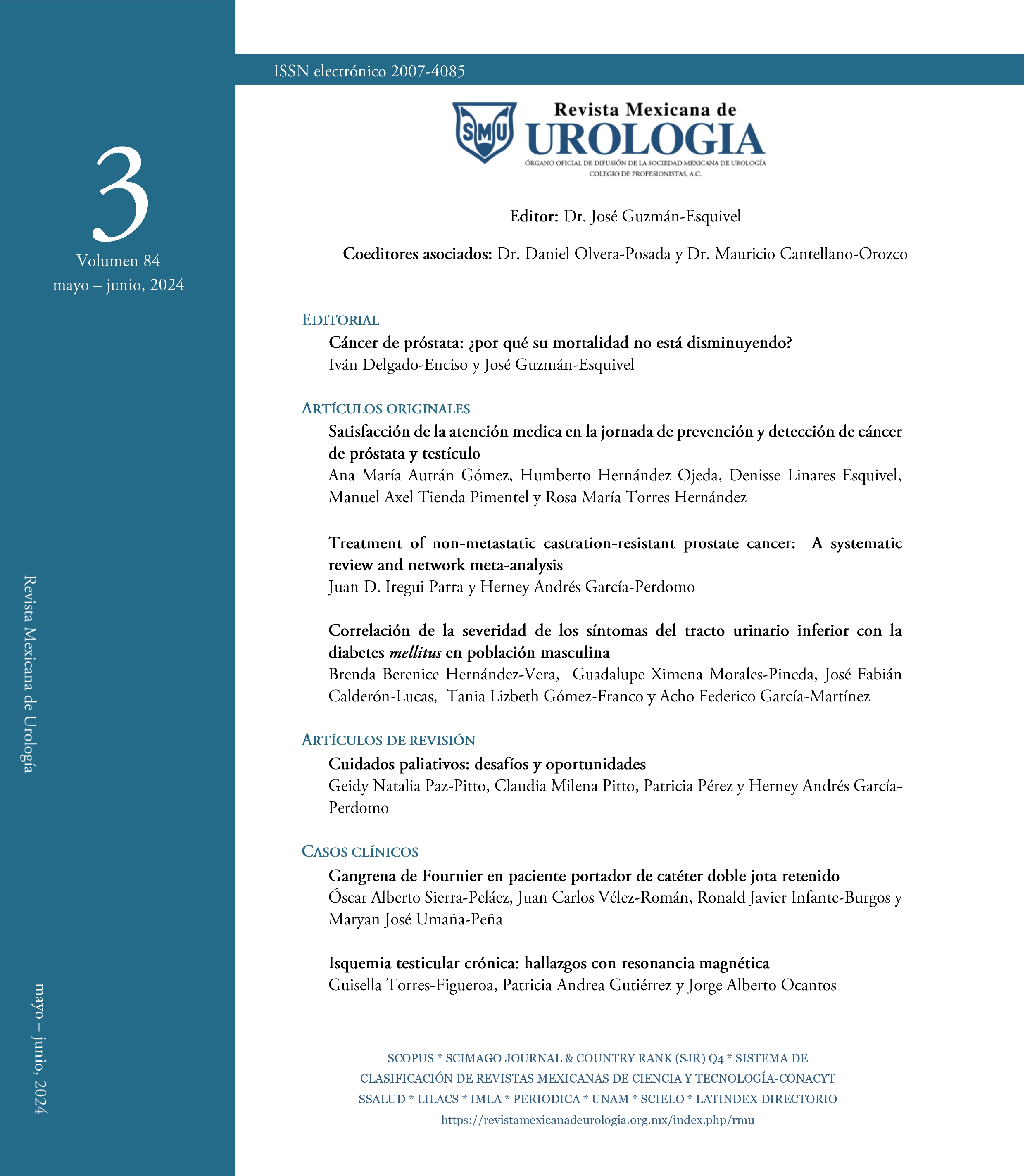Tratamiento del cáncer de próstata no metastásico resistente a la castración: una revisión sistemática y un metaanálisis
DOI:
https://doi.org/10.48193/gg634d97Palabras clave:
Apalutamida , darolutamida, enzalutamida, supervivencia libre de metástasis, cáncer de próstata, no metastásicoResumen
Background: Patients with non-metastatic prostate cancer treated with androgen deprivation therapy develop castration resistance after an average of 19 months. Non-metastatic castration-resistant prostate cancer (M0CRPC) refers to biochemical progression despite medical or surgical castration.
Purpose: To determine the effectiveness of the available interventions for treating non-metastatic castration-resistant prostate cancer (M0CRPC).
Methods: We performed a search strategy in MEDLINE via Ovid, EMBASE, CENTRAL, and LILACS. We included phase II and phase III clinical trials whose primary objective was to evaluate the effectiveness of the intervention in a patient with M0CRPC (primary outcome metastasis-free survival). We excluded studies that included patients with multimodal treatment. We performed the statistical analysis in R and Review Manager 5.3 (RevMan 5.3).
Results: We found a total of 1376 studies. After screening, we selected three studies for qualitative analysis. In the analysis of the three included studies, a total of 4117 patients older than 18 years had non-metastatic castration-resistant prostate cancer. The interventions evaluated were apalutamide, enzalutamide, and darolutamide. All trials demonstrated a significant increase in MFS with the evaluated intervention in patients with nmCRPC. The indirect comparison showed that the three option is better than placebo, but apalutamide and enzalutamide are better than darolutamide.
Conclusion: In non-metastatic patients, CRPC apalutamide and enzalutamide provide a lower risk of metastasis than darolutamide. Also, there were no differences between apalutamide and enzalutamide.
Referencias
Scher HI, Solo K, Valant J, Todd MB, Mehra M. Prevalence of Prostate Cancer Clinical States and Mortality in the United States: Estimates Using a Dynamic Progression Model. PLOS ONE. 2015;10(10): e0139440. https://doi.org/10.1371/journal.pone.0139440.
Chandrasekar T, Yang JC, Gao AC, Evans CP. Mechanisms of resistance in castration-resistant prostate cancer (CRPC). Translational Andrology and Urology. 2015;4(3): 365–380. https://doi.org/10.3978/j.issn.2223-4683.2015.05.02.
Sharifi N, Dahut WL, Steinberg SM, Figg WD, Tarassoff C, Arlen P, et al. A retrospective study of the time to clinical endpoints for advanced prostate cancer. BJU international. 2005;96(7): 985–989. https://doi.org/10.1111/j.1464-410X.2005.05798.x.
Smith MR, Kabbinavar F, Saad F, Hussain A, Gittelman MC, Bilhartz DL, et al. Natural history of rising serum prostate-specific antigen in men with castrate nonmetastatic prostate cancer. Journal of Clinical Oncology: Official Journal of the American Society of Clinical Oncology. 2005;23(13): 2918–2925. https://doi.org/10.1200/JCO.2005.01.529.
Scher HI, Morris MJ, Stadler WM, Higano C, Basch E, Fizazi K, et al. Trial Design and Objectives for Castration-Resistant Prostate Cancer: Updated Recommendations From the Prostate Cancer Clinical Trials Working Group 3. Journal of Clinical Oncology: Official Journal of the American Society of Clinical Oncology. 2016;34(12): 1402–1418. https://doi.org/10.1200/JCO.2015.64.2702.
Di Nunno V, Mollica V, Santoni M, Gatto L, Schiavina R, Fiorentino M, et al. New Hormonal Agents in Patients With Nonmetastatic Castration-Resistant Prostate Cancer: Meta-Analysis of Efficacy and Safety Outcomes. Clinical Genitourinary Cancer. 2019;17(5): e871–e877. https://doi.org/10.1016/j.clgc.2019.07.001.
Roviello G, Gatta Michelet MR, D’Angelo A, Nobili S, Mini E. Role of novel hormonal therapies in the management of non-metastatic castration-resistant prostate cancer: a literature-based meta-analysis of randomized trials. Clinical & Translational Oncology: Official Publication of the Federation of Spanish Oncology Societies and of the National Cancer Institute of Mexico. 2020;22(7): 1033–1039. https://doi.org/10.1007/s12094-019-02228-2.
Hussain M, Fizazi K, Saad F, Rathenborg P, Shore N, Ferreira U, et al. Enzalutamide in Men with Nonmetastatic, Castration-Resistant Prostate Cancer. New England Journal of Medicine. 2018;378(26): 2465–2474. https://doi.org/10.1056/NEJMoa1800536.
Burki T. Darolutamide for non-metastatic, castration-resistant prostate cancer. The Lancet Oncology. 2019;20(3): e139. https://doi.org/10.1016/S1470-2045(19)30102-0.
Smith MR, Saad F, Chowdhury S, Oudard S, Hadaschik BA, Graff JN, et al. Apalutamide Treatment and Metastasis-free Survival in Prostate Cancer. New England Journal of Medicine. 2018;378(15): 1408–1418. https://doi.org/10.1056/NEJMoa1715546.
Hegemann M, Bedke J, Stenzl A, Todenhöfer T. Denosumab treatment in the management of patients with advanced prostate cancer: clinical evidence and experience. Therapeutic Advances in Urology. 2017;9(3–4): 81–88. https://doi.org/10.1177/1756287216686018.
Boudadi K, Antonarakis ES. Resistance to Novel Antiandrogen Therapies in Metastatic Castration-Resistant Prostate Cancer. Clinical Medicine Insights. Oncology. 2016;10(Suppl 1): 1–9. https://doi.org/10.4137/CMO.S34534.
Clegg NJ, Wongvipat J, Joseph JD, Tran C, Ouk S, Dilhas A, et al. ARN-509: a novel antiandrogen for prostate cancer treatment. Cancer Research. 2012;72(6): 1494–1503. https://doi.org/10.1158/0008-5472.CAN-11-3948.
Heinrich D, Russnes KM, Oldenburg J. Re: Apalutamide Treatment and Metastasis-free Survival in Prostate Cancer. European Urology. 2018;74(2): 236–237. https://doi.org/10.1016/j.eururo.2018.04.010.
Taneja SS. Re: Enzalutamide in Men with Nonmetastatic, Castration-Resistant Prostate Cancer. The Journal of Urology. 2019;201(1): 31. https://doi.org/10.1097/01.ju.0000550155.71767.b1.
Penson DF, Armstrong AJ, Concepcion R, Agarwal N, Olsson C, Karsh L, et al. Enzalutamide Versus Bicalutamide in Castration-Resistant Prostate Cancer: The STRIVE Trial. Journal of Clinical Oncology: Official Journal of the American Society of Clinical Oncology. 2016;34(18): 2098–2106. https://doi.org/10.1200/JCO.2015.64.9285.
Publicado
Número
Sección
Licencia
Derechos de autor 2024 Revista Mexicana de Urología

Esta obra está bajo una licencia internacional Creative Commons Atribución-NoComercial-SinDerivadas 4.0.






